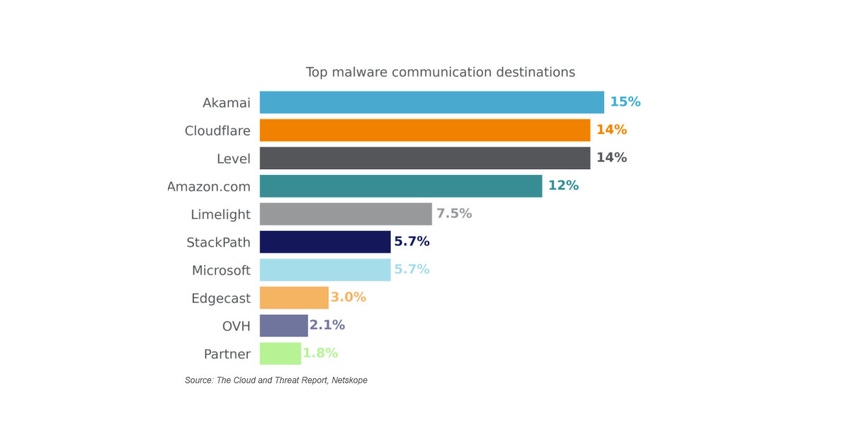
Cybersecurity In-Depth: Digging into data about the latest attacks, threats, and trends using charts and tables.
One way to hide malicious activity is to make it look benign by blending in with regular traffic passing through content delivery networks (CDNs) and cloud service providers, according to a Netskope report.

Attackers are abusing widely used cloud services and applications to deliver malware and hiding the malware's post-infection activities by routing them over common network ports and well-recognizing content delivery networks (CDNs) and cloud providers, Netskope said in its latest "Cloud and Threat Report." The report provides intelligence on active malware threats against enterprise users. On average, five out of every 1,000 enterprise users attempted to download malware in the first quarter of 2023, it states.
After the malware infects a victim machine, it establishes a communication channel with its home server to download additional malware payloads, execute commands, and exfiltrate data. Attackers are increasingly routing malware communications through IP addresses belonging to well-known CDNs and cloud service providers, primarily Akamai and Cloudflare. Amazon Web Services, Microsoft Azure, and Limelight are also commonly abused.
Only a small fraction of total Web malware downloads were delivered over methods recognized as risky, such as newly registered domains and uncategorized sites, the report points out.
In the first quarter, 72% of all malware downloads detected by Netskope were new, the company reports. Attackers delivered malware by abusing widely used services and applications, such as OneDrive, SharePoint, Amazon S3 buckets, GitHub, Weebly, Dropbox, Google Drive, Box, Google’s Gmail service, and Azure Blob Storage. According to Netskope, attackers had used 261 distinct apps in the first quarter for malware downloads.
“Cloud apps are also commonly abused as a form of social engineering, where attackers use app features familiar to the victims to entice them into downloading malware,” Netskope’s team states.
About the Author(s)
You May Also Like
The fuel in the new AI race: Data
April 23, 2024Securing Code in the Age of AI
April 24, 2024Beyond Spam Filters and Firewalls: Preventing Business Email Compromises in the Modern Enterprise
April 30, 2024Key Findings from the State of AppSec Report 2024
May 7, 2024Is AI Identifying Threats to Your Network?
May 14, 2024
Black Hat USA - August 3-8 - Learn More
August 3, 2024Cybersecurity's Hottest New Technologies: What You Need To Know
March 21, 2024

